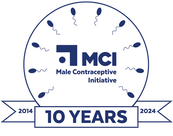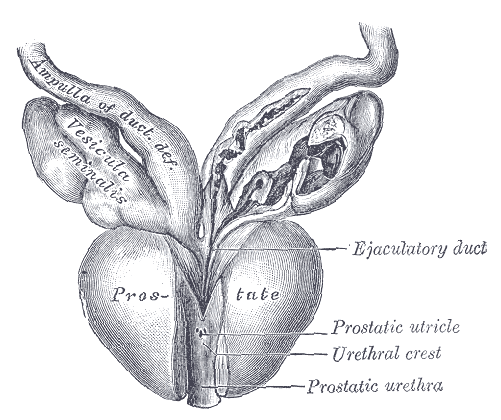|
(Image source: Henry Vandyke Carter, in public domain) The ejaculatory ducts are a part of the male anatomy that allows the flow of sperm from the testes through the reproductive system and eventually out through the urethra. After sperm are created in the testes and matured in the epididymis, the event of ejaculation moves sperm through the epididymis and into the vas deferens via smooth muscle contractions. Each testicle has a separate vas deferens, which move up out of the scrotum and into the body, joining together to create the beginning of the ejaculatory ducts. After leaving the vas deferens, sperm from the testes and epididymis move through the ejaculatory ducts and mix with emissions from the prostate gland and seminal vesicles. Further muscle contractions push these emissions out of the prostatic structures and prepare it for expulsion. These emissions nourish sperm, keeping them active and motile, as well as protect them in the acidic vaginal environment. After these emissions and sperm mix together, they become ejaculate. Upon the expulsion stage of ejaculation, this ejaculate exits the ejaculatory ducts, and enters the urethra, the last physiological structure before muscle contractions propel the ejaculatory mixture from the body. Nuts & Bolts: Ejaculatory Ducts To learn more about, please visit our series of posts about male reproduction and contraception: Key Terms: Ejaculate - the male reproductive fluid, containing spermatozoa in suspension. Epididymis - a tube that connects a testicle to a ductus deferens in the male reproductive system. Scrotum - a feature of the male reproductive system that hangs from the body at the front of the pelvis, between the legs. Sperm - the mature motile male sex cell of an animal, by which the ovum is fertilized, typically having a compact head and one or more long flagella for swimming. Testes - an organ which produces spermatozoa (male reproductive cells). Urethra - the duct by which urine is conveyed out of the body from the bladder, and which in male vertebrates also conveys semen. Vas deferens - the duct which conveys sperm from the testicle to the urethra. For additional terminology related to male contraception and the male reproductive system, please visit our glossary: Sources/References: Jones, R. E. (2012). Human reproductive biology. Elsevier Science. http://CPIT.eblib.com.au/patron/FullRecord.aspx?p=1129887 Mathangasinghe, Y., Samaranayake, U. M. J. E., Dolapihilla, B. N., Anthony, D. J., & Malalasekera, A. P. (2020). Morphology of ejaculatory ducts: A systematic review. Clinical Anatomy (New York, N.Y.), 33(8), 1164–1175. https://doi.org/10.1002/ca.23557 Verze, P., Cai, T., & Lorenzetti, S. (2016). The role of the prostate in male fertility, health and disease. Nature Reviews. Urology, 13(7), 379–386. https://doi.org/10.1038/nrurol.2016.89 For additional publications related to male contraception and the male reproductive system, please visit our publications page:
Comments are closed.
|
Categories
All
Archives
June 2024
|
|
|
Donate to Male Contraceptive InitiativeYour generous donation makes a difference!
|
© Male Contraceptive Initiative. All rights reserved.


 RSS Feed
RSS Feed
